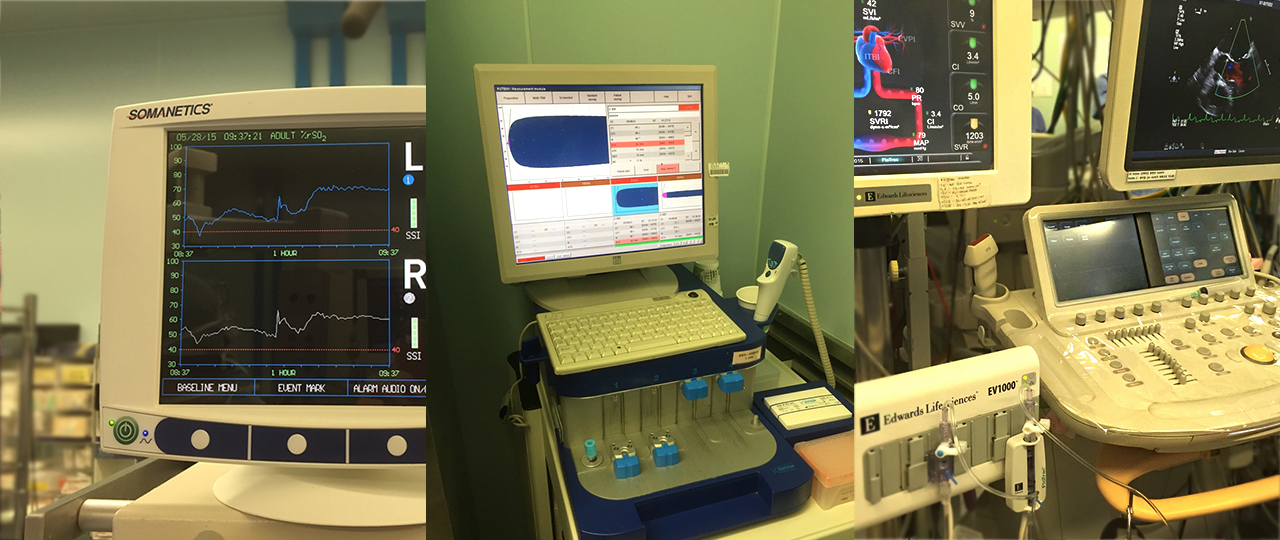麻醉与疼痛科

三星医疗中心(Samsung Medical Center)麻醉与疼痛科秉承“以患者为中心的麻醉管理”。我们为主建筑的25间手术室里的器官移植、心血管外科及脑与神经系统外科实施麻醉;为综合手术室里的心脑血管外科实施麻醉;为肿瘤专科医院的20间手术室里的肺、食道、脑及喉癌实施麻醉;为普通建筑/医院里的外科及膀胱癌实施麻醉;及在两间机器人辅助手术室里实施麻醉。
在附属建筑的11间手术室里,我们在不需许可的情况下为简单的外科实施麻醉,包括日间外科中心、眼科手术及泌尿系统与甲状腺手术。另外,我们每年会在手术室外为放射科的血管造影介入、肝及肾肿瘤的高频消融治疗、儿科患者的镇静、浅表性胃食道癌的支持切除麻醉实施大约4000例麻醉。在主建筑的地下室里我们运营一间疼痛处理诊所及急性疼痛处理室以专注于急性及慢性疼痛处理,包括术后疼痛。
优势项目
1. 提供最好的癌症信息服务
自从1996年5月在三星医疗中心的第一例肝移植以来,截至2015年5月,我们已经实施了1626例肝移植。肝移植的麻醉由专长于该类型麻醉的专家依据SMC协定与指引实施,该协定与指引相应地以过去20年积累的临床经验及基于研究的证据为依据。我们的肝移植麻醉团队已经在过去3年里在世界一流期刊发表文章以获得全球公认,并正在努力地作为肝移植的领导者交付及分享我们的经验与专业知识以在世界范围内移植中心。这就是每年许多肝移植医生参观我们医院的原因。
2. 心血管手术麻醉
三星医疗中心的心血管手术麻醉团队配备专职人员及各种最新的监测设备以确保患者的安全及最佳的手术效果与手术期间他们的预后。在主建筑的手术室里,每年有1400例 心脏手术,包括成人冠状动脉旁路移植手术、主动脉疾病、心脏瓣膜疾病、心脏移植、心律失常及小儿先天性心脏病手术。另外除手术室外,我们有4间操作室,我们在那里实施先天性心脏病及主动脉疾病的经皮修复经皮主动脉瓣植入,并且在2015年我们计划开设一间新的综合室,配置最新的设备,在那里我们将实施同时经皮操作及进行心律失常的开心手术。
3. 机器人辅助手术的麻醉
我们依据大量的经验与研究结果为有许多并存病的老年患者提供最合适及安全的麻醉。对于进行机器人辅助手术的患者来说,我们使用通风方法,该方法最低限度地降低由胸内压增加引起的肺通气问题,并处理各种并存病,如老年患者的心血管病、肺病及糖尿病以最低限度地降低来自长时间手术的不良反应的发生。由于我们积极地提供放松及疼痛控制以保持患者的术前及术后舒适来配合微创机器人手术的好处,患者安全及满意度会非常高。
4. 脑与神经系统的麻醉
在脑与神经系统麻醉方面拥有各种经验的委员会认证的麻醉师为脑肿瘤、血管畸形提供合适的麻醉,如脑动脉瘤、癫痫、外伤性病变、各种脊柱疾病、小儿脑肿瘤及烟雾病。当在整个手术期间维持脑血流动及增氧时,我们提供最充分的神经外科手术麻醉。我们也实施高难度麻醉,如醒脑手术麻醉,以检查当实施特定位置的肿瘤手术时患者是否能够在手术期间服从指令。为了患者的安全我们提供不仅在手术室里提供麻醉,也为由放射科实施的脑血管手术提供麻醉。
5. 肺与食道麻醉
在韩国我们有最好的肺癌与食道癌外科治疗中心(2010 - 2014: 4731例肺叶切除及1036例食道癌根治外科手术),并且我们以各种与我们名声相一致的麻醉方法进行手术及康复。我们系统地实施高难度插管、单肺通气、肺及主要器官的术中保护技术及术后疼痛控制(硬膜外镇痛、脊柱旁阻滞及伤口阻滞及病人自控性镇痛),并且通过对外科病人实施每天管理的小组会议实现全球最低限度的发病率和死亡率。
6. 儿科患者的MRI/CT测试麻醉
对于儿童进行中的MRI/CT检查,儿科镇静麻醉由医务人员在麻醉与疼痛科里实施。对儿童来说离开其父母感到恐惧及分离焦虑是普遍的,这会使实施MRI/CT检查变得困难。当实施这些测试时,我们使用少量的麻醉药以使儿科患者放松,保持适当的镇静/麻醉。期间,我们会监控儿童的呼吸及心肺功能,以确保他们的安全。
7. 小儿骨科麻醉
当儿科患者相对于成人在麻醉开始/终止上显示高频率的呼吸不良反应时,使用喉罩而不是大部分儿科患者使用的气管导管,以防止手术中的此类影响。我们医院最近数据显示,在实施儿科患者的矫形手术时使用喉罩率已经达到70%,而且在韩国及全球这是一个非常高的水平。另外,为防止对手术室环境及麻醉中的清醒的消极情绪产生的心理创伤,麻醉前我们引诱遗忘以考虑患者的安全、身体及心理健康。
8. 耳鼻喉麻醉
耳鼻喉科治疗的疾病包括各种与耳、鼻及喉相关的疾病及所有脑及喉肿瘤(除眼肿瘤外)。适当的麻醉处理对各种治疗这些疾病的外科治疗来说是必要的。三星医疗中心的耳鼻喉麻醉团队每年实施大约3500例耳鼻喉麻醉,包括婴幼儿麻醉、儿科麻醉、日间手术麻醉及重症监护患者麻醉。我们应用最新的麻醉设备及生命体征检测设备以提高一个更安全及更专业的耳鼻喉麻醉服务。
9. 疼痛门诊介绍
在疼痛门诊里,我们诊断及治疗全身各种慢性疼痛,除那些能够单独通过内科或外科治疗治愈的疼痛外。我们通过药物治疗、物理疗法、神经阻滞及神经疲惫法阻止消极的疼痛反应循环,并且通过稳定周围及中枢神经系统的兴奋度治疗疼痛。通过与其它科室的紧密合作,使用多学科方法,我们治疗肌肉骨骼疼痛,包括单纯及带状疱疹后疼痛、各种原因的背痛、放射痛、肌筋膜痛综合症、头痛及面部疼痛、肩颈痛、腹痛、幻觉痛、复合区疼痛综合征及癌痛。我们研究并不仅致力实施神经阻滞,也致力实施激光手术、神经成形术及为顽固性疼痛植入脊髓刺激器。